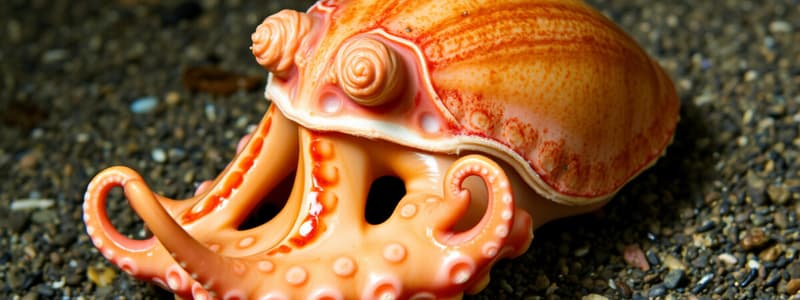Podcast
Questions and Answers
Which of the following are included in Class Cephalopoda?
Which of the following are included in Class Cephalopoda?
- Cuttlefish
- Squid
- Octopi
- All of the above (correct)
Class Cephalopoda are the least advanced mollusca.
Class Cephalopoda are the least advanced mollusca.
False (B)
What are some characteristics of Cephalopoda?
What are some characteristics of Cephalopoda?
Chambered shell (if present), tentacles surrounding mouth, radula and beak, closed circulatory system, high degree of cephalization, image-forming eyes.
Cephalopoda have a BLANK circulatory system.
Cephalopoda have a BLANK circulatory system.
What is the Subclass Nautioidea known for?
What is the Subclass Nautioidea known for?
What are siphuncles?
What are siphuncles?
Siphuncles can withdraw completely into the shell.
Siphuncles can withdraw completely into the shell.
What is the Subclass Ammonoidea known for?
What is the Subclass Ammonoidea known for?
What are the characteristics of Subclass Coleoidea?
What are the characteristics of Subclass Coleoidea?
What do chromatophore organs contain?
What do chromatophore organs contain?
Chromatophores produce 3 different colors: brown, yellow, & BLANK.
Chromatophores produce 3 different colors: brown, yellow, & BLANK.
How do chromatophores produce different colors?
How do chromatophores produce different colors?
What distinguishes Order Sepiodea?
What distinguishes Order Sepiodea?
What are the characteristics of Sepiodea?
What are the characteristics of Sepiodea?
Cuttlefish bones are characterized as:
Cuttlefish bones are characterized as:
What does the Order Teuthoida consist of?
What does the Order Teuthoida consist of?
What are the characteristics of Teuthoida?
What are the characteristics of Teuthoida?
What is the gladius in Teuthoida?
What is the gladius in Teuthoida?
Teuthoida are the BLANK inverts.
Teuthoida are the BLANK inverts.
How can Teuthoida use their siphon?
How can Teuthoida use their siphon?
What is represented by Order Octopoda?
What is represented by Order Octopoda?
What are the characteristics of Octopoda?
What are the characteristics of Octopoda?
Where is the Dumbo Octopus found?
Where is the Dumbo Octopus found?
Cephalopods are hermaphroditic.
Cephalopods are hermaphroditic.
Flashcards are hidden until you start studying
Study Notes
Class Cephalopoda Overview
- Includes cuttlefish, squid, and octopus.
- Recognized as the most advanced group within the mollusks.
Distinctive Features of Cephalopoda
- Possess a chambered shell (if present) and tentacles surrounding the mouth.
- Features a radula and beak, along with a closed circulatory system.
- Highly developed neural organization (cephalization) and image-forming eyes.
- Contains a large mantle cavity with a muscular funnel (siphon).
- Typically features 1-2 pairs of ctenidia (gills) and nephridia (excretory organs).
- Carnivorous lifestyle, exhibiting gonochoristic reproduction (separate sexes).
Circulatory System
- Cephalopoda have a closed circulatory system enabling faster movement.
Subclass Nautioidea
- Solecephalopods with an external chambered shell.
- Have pinhole eyes without cornea or lens, and possess 80-90 suckerless tentacles.
- Lack chromatophores and ink sac; regarded as "living fossils."
Siphuncles
- Structures that connect shell chambers, allowing adjustment of buoyancy by manipulating water and gas content.
Subclass Ammonoidea
- Extinct cephalopods that coexisted with dinosaurs and serve as significant index fossils.
- Present sexual dimorphism complicates species determination.
Subclass Coleoidea
- Comprises cuttlefish, octopuses, and squid, known for advanced adaptations.
Characteristics of Coleoidea
- Equipped with 8-10 prehensile arms covered with suckers.
- Possess a pair of ctenidia and nephridia; internal shells may be vestigial or absent.
- Have well-developed eyes with cornea and lens, along with chromatophores and an ink sac for defense and communication.
Chromatophores
- Composed of specialized cells (chromatophore, iridophore, muscle, nerve, and glial cells) for rapid color change via neural control.
- Produce colors such as brown, yellow, and other shades by contracting and expanding.
Order Sepiodea
- Represents cuttlefish, characterized by a dorsally flattened body, lateral fins, and unique feeding adaptations.
Sepiodea Features
- Possess 8 short arms and 2 long feeding tentacles without hooks, targeting fish and crustaceans.
- Cuttlefish bones are hollow, with internal chambers aiding in buoyancy control.
Order Teuthoida
- Known as squid; recognized for their streamlined body designed for speed.
Teuthoida Characteristics
- Comprising 8 short arms and 2 long non-retractable tentacles; possess a vestigial internal shell called the gladius.
- Adaptations for pelagic life, with suckers often reinforced with hooks.
Teuthoida Adaptations
- Utilize a siphon to propulse and navigate swiftly in water.
Order Octopoda
- Represent octopuses, which are recognizable for their unique body structure.
Octopoda Characteristics
- Lack a shell, exhibit 8 arms, and typically occupy benthic marine environments.
- Primary prey includes mollusks and crustaceans.
Notable Species
- The Dumbo octopus thrives in deep-sea habitats, exemplifying cephalopod diversity.
Reproductive Biology
- Cephalopods possess separate sexes and are not hermaphroditic, reflecting varied reproductive strategies.
Studying That Suits You
Use AI to generate personalized quizzes and flashcards to suit your learning preferences.




